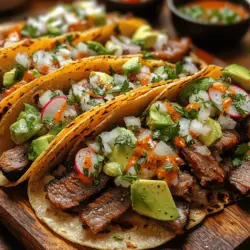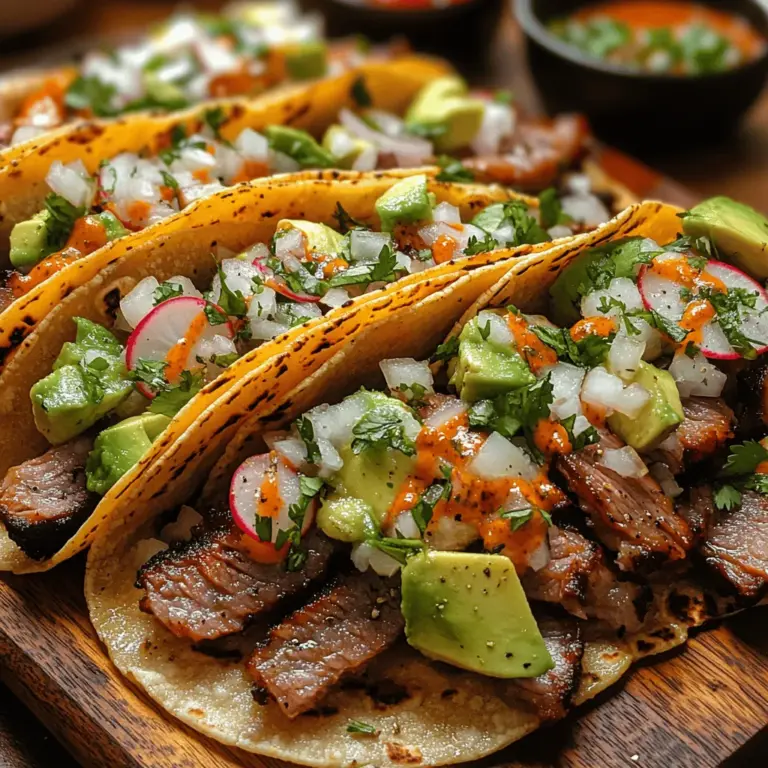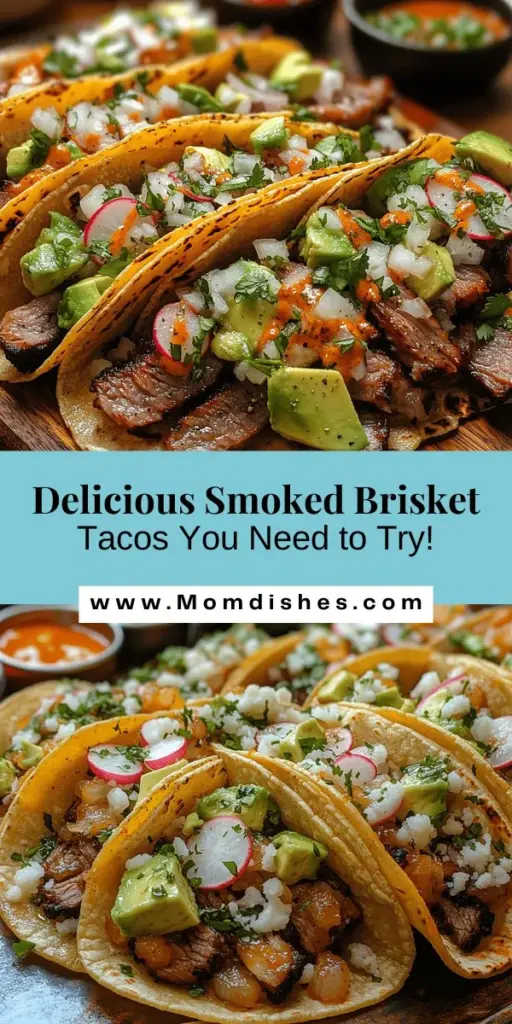Introduction
Smoked brisket tacos are a culinary delight that combines the rich, savory flavors of expertly smoked meat with the vibrant and versatile nature of tacos. This dish stands out in the ever-popular taco genre, offering a unique twist that can transform any gathering or celebration into a flavorful feast. The smoky aroma of brisket, paired with fresh toppings and a soft tortilla, creates a mouthwatering experience that will captivate both your taste buds and those of your guests.
Tacos, in their many forms, have long been a staple in Mexican cuisine, symbolizing comfort and communal enjoyment. However, when you introduce smoked brisket into the mix, you elevate this classic dish to new heights. The process of slow-smoking brisket not only enhances its natural flavors but also infuses it with a depth that is hard to replicate through traditional cooking methods. The satisfaction of preparing smoked brisket from scratch is a rewarding experience that showcases your culinary skills and impresses friends and family alike.
As you embark on this flavorful journey, prepare to learn the essential steps in creating smoked brisket tacos that will have everyone coming back for seconds. From selecting the right cut of meat to mastering the smoking process, this recipe offers a comprehensive guide to achieving taco perfection.
Understanding Brisket: The Star Ingredient
At the heart of smoked brisket tacos is the brisket itself, a cut of meat that is revered for its rich flavor and tender texture when cooked properly. Brisket comes from the breast area of the cow and consists of two main muscles: the flat and the point. The flat is leaner and often used for slicing, while the point is fattier, providing a more robust flavor that is ideal for shredding. Understanding these characteristics is essential for selecting the right brisket for your tacos.
When choosing a brisket, quality is paramount. Opt for a well-marbled cut, as the intramuscular fat will render during the cooking process, keeping the meat moist and flavorful. A brisket with a good fat cap is also desirable, as it can provide additional flavor and protection during smoking. Look for cuts that have a bright red color and firm texture, and avoid any that appear dull or have excessive discoloration.
The preparation of the brisket is just as important as the selection. A well-crafted dry rub serves to enhance the natural flavors of the meat and creates a flavorful crust during the smoking process. The rub typically consists of a blend of spices and seasonings that harmonize beautifully with the brisket, adding layers of flavor that will tantalize your taste buds.
Preparing the Brisket: The Essential Steps
Trimming the Brisket
Before diving into the seasoning, it’s crucial to properly trim the brisket. This step is essential for achieving the ideal fat-to-meat ratio, which will impact the final texture and flavor of your tacos. Start by placing the brisket on a clean cutting board, fat side up. Using a sharp knife, carefully trim away any excess fat, leaving about a quarter-inch layer for moisture retention during cooking. Be mindful not to remove too much, as the fat is what helps keep the brisket juicy and flavorful. Additionally, remove any silverskin or connective tissue that may hinder the absorption of the rub.
Crafting the Dry Rub
The dry rub is a vital component of smoked brisket, as it infuses the meat with flavor and creates a delicious crust. Here’s a breakdown of the ingredients and their roles in the rub:
1. Coarse Kosher Salt: This is the foundation of your rub. It enhances the natural flavors of the brisket and helps with moisture retention.
2. Black Pepper: Adds depth and a subtle heat that balances the richness of the brisket.
3. Paprika: Provides a mild, smoky flavor and contributes to the rub’s vibrant color.
4. Garlic Powder and Onion Powder: These aromatics add a savory base that complements the meat beautifully.
5. Cayenne Pepper: For those who enjoy a kick, cayenne can be adjusted to taste, adding a touch of heat.
6. Ground Cumin: Offers earthy notes that enhance the overall flavor profile of the dish.
7. Brown Sugar: This ingredient adds a hint of sweetness that helps create a caramelized crust during smoking.
To prepare the dry rub, combine the above ingredients in a bowl, mixing well to ensure an even distribution.
Applying the Dry Rub and Marinating
Once you have your dry rub ready, it’s time to apply it to the brisket. Generously coat the entire surface of the meat, ensuring that the rub adheres well and penetrates the meat. Don’t be shy—this is your chance to build layers of flavor.
After applying the dry rub, it’s best to let the brisket marinate for several hours, or ideally, overnight in the refrigerator. This resting period allows the flavors to meld and deeply penetrate the meat, resulting in a more flavorful brisket once smoked. If you’re short on time, aim for at least one hour of marinating, but longer is always better.
The Smoking Process: Achieving the Perfect Brisket
With your brisket prepped and marinated, it’s time to move on to the smoking process, which is where the magic truly happens. A well-smoked brisket can take your tacos from good to unforgettable.
Preheating the Smoker
The first step in the smoking process is preheating your smoker. Temperature control is crucial, as brisket benefits from low and slow cooking. Aim for a steady temperature between 225°F and 250°F. This range allows the collagen in the meat to break down gradually, resulting in a tender and juicy brisket.
Choosing the Right Wood Chips
The type of wood chips you use can significantly impact the flavor profile of your smoked brisket. Common choices include hickory, oak, and mesquite, each imparting its unique flavor. Hickory adds a strong smoky flavor, while oak provides a milder, more balanced smoke. Mesquite, on the other hand, delivers a bold, earthy taste that pairs well with beef. Experimenting with different woods can yield exciting results, allowing you to customize the flavor of your smoked brisket.
Smoking Times and Temperatures
Once your smoker is preheated and the wood chips are selected, it’s time to place the brisket inside. Smoking times will vary based on the size of the brisket, but a general rule of thumb is to allocate about 1 to 1.5 hours of smoking time per pound of meat. Use a meat thermometer to monitor the internal temperature of the brisket. The goal is to achieve an internal temperature of around 195°F to 205°F, which is where the collagen breaks down sufficiently, resulting in a tender, melt-in-your-mouth texture.
Monitoring the Brisket
Throughout the smoking process, it’s essential to keep an eye on the temperature and moisture levels. You may need to add more wood chips or adjust the airflow to maintain a consistent temperature. It’s also a good idea to spritz the brisket with a mixture of apple cider vinegar and water every hour or so. This helps keep the surface moist and enhances the bark, or crust, that develops during smoking.
By following these initial steps in preparing and smoking your brisket, you are well on your way to creating a mouthwatering smoked brisket taco experience that will leave a lasting impression. Stay tuned for the next part, where we will delve into assembling the tacos and adding the perfect finishing touches.
{{image_1}}
The Texas Crutch: Wrapping the Brisket for Moisture Retention
One of the secrets to achieving perfectly tender smoked brisket is the technique known as the Texas Crutch. This involves wrapping the brisket in foil or butcher paper during the cooking process, which helps retain moisture and enhances flavor. After your brisket has smoked for several hours and has developed a beautiful bark on the outside, it’s time to embrace the Texas Crutch. When the internal temperature of the brisket reaches around 160°F, carefully remove it from the smoker and wrap it tightly in aluminum foil or butcher paper. If using foil, ensure it is sealed well to trap steam, while butcher paper allows for some moisture to escape, which can help maintain the bark’s texture.
As you continue cooking, keep an eye on the internal temperature. The goal is to reach about 195°F to 205°F for optimal tenderness. Using a reliable meat thermometer will help you avoid overcooking and ensure your brisket is perfectly juicy. Once you reach the desired temperature, remove the brisket from the heat source.
Resting the Brisket: The Key to Juiciness
Once you’ve successfully smoked and wrapped your brisket, the next crucial step is resting. Resting is essential as it allows the juices to redistribute throughout the meat, resulting in a more flavorful and moist final product. If you slice the brisket immediately after cooking, you risk losing the flavorful juices that have been trapped in the meat during the smoking process.
For best results, let your brisket rest for at least 30 minutes to an hour before slicing. You can keep it wrapped in foil and place it in a cooler or an insulated container to maintain warmth during this resting period. This step is not just a suggestion; it’s a vital part of achieving that melt-in-your-mouth texture that makes smoked brisket tacos truly exceptional.
Creating the Tacos: A Flavorful Assembly
Now that your brisket is perfectly smoked and rested, it’s time to build those delicious tacos. Begin by preparing your tortillas, which can significantly affect the overall experience of your dish.
Preparing the Tortillas
Warming your tortillas is key to ensuring they are pliable and easy to fold without tearing. You can warm them on a dry skillet over medium heat for about 30 seconds on each side. Alternatively, wrapping them in foil and placing them in a warm oven can also keep them warm and soft.
When choosing between corn and flour tortillas, consider their flavor profiles. Corn tortillas offer a slightly nutty taste that complements the smoky brisket beautifully, while flour tortillas provide a soft, chewy texture. Both options work well, so choose based on your preference!
Step-by-Step Assembly of the Tacos
1. Slice the Brisket: After resting, slice the brisket against the grain into thin strips. This technique helps break down the muscle fibers, ensuring each bite is tender.
2. Layer the Ingredients: Start by placing a generous amount of sliced brisket in the center of your warmed tortilla. Next, add fresh toppings:
– Raw onions: Thinly sliced onions add a sharp, crunchy texture.
– Cilantro: Fresh cilantro provides a burst of herbaceous flavor.
– Radishes: Thinly sliced radishes add a crisp, peppery bite.
– Avocado: Creamy avocado introduces richness and balances the flavors.
3. Cheese Options: Consider adding cheese to enhance the taco experience. Queso fresco is a popular choice, offering a mild, crumbly texture. Alternatively, shredded cheese (like cheddar or Monterrey Jack) can provide a melty, savory element.
4. Finishing Touches: Squeeze fresh lime juice over the assembled tacos for brightness and a touch of acidity. A dash of your favorite hot sauce can elevate the spice level and flavor complexity.
Serving Suggestions: Elevating the Taco Experience
Presentation is key when it comes to serving your smoked brisket tacos. Arrange the tacos on a large platter, garnished with lime wedges and additional toppings, like chopped cilantro and sliced jalapeños, to invite guests to customize their creations.
To complement your tacos, consider serving side dishes that enhance the meal. Traditional options include:
– Mexican street corn: Grilled corn on the cob slathered in mayo, lime juice, and cheese.
– Refried beans or black beans: A hearty side that pairs well with the rich brisket.
– Fresh salsa or pico de gallo: Bright, fresh flavors that cut through the richness of the tacos.
Beverage pairings can elevate the dining experience further. Serve with light beers, margaritas, or refreshing agua frescas to cleanse the palate between bites. Don’t forget to place fresh lime wedges and additional hot sauce on the table for those who enjoy a bit more heat.
Nutritional Insights: A Balanced Approach
Smoked brisket tacos can be a nutritious meal when prepared mindfully. Brisket is an excellent source of protein, which is essential for muscle repair and overall health. Additionally, the healthy fats found in avocado contribute to heart health and satiety.
For a balanced meal, consider incorporating additional vegetables into your tacos or serving a side salad. Adding leafy greens, tomatoes, or bell peppers can provide essential vitamins and minerals. You might also consider a light slaw made with cabbage and carrots to add crunch and color, as well as a dose of fiber.
Conclusion
Making smoked brisket tacos at home is a rewarding culinary adventure that brings joy and satisfaction to both the cook and those lucky enough to share the meal. The process of smoking the brisket, assembling the tacos with fresh ingredients, and enjoying the final product with friends and family creates a communal experience that celebrates culinary creativity.
As you explore different toppings and variations, don’t hesitate to experiment with flavors and ingredients that resonate with your personal taste. Whether it’s a unique salsa, different cheese types, or fresh herbs, the world of tacos is vast and vibrant.
So gather your loved ones, fire up the smoker, and embrace the deliciousness of homemade smoked brisket tacos. You’re not just serving food; you’re creating memories that will be cherished long after the last bite has been taken.


